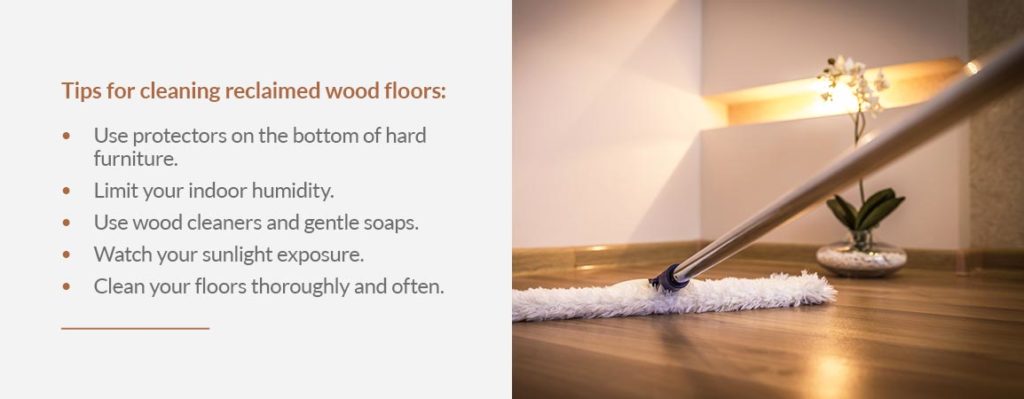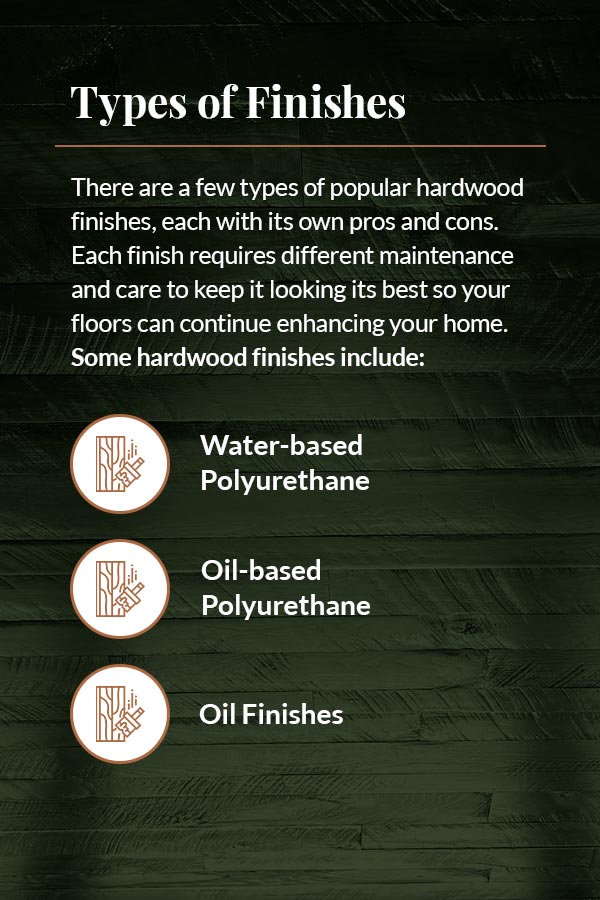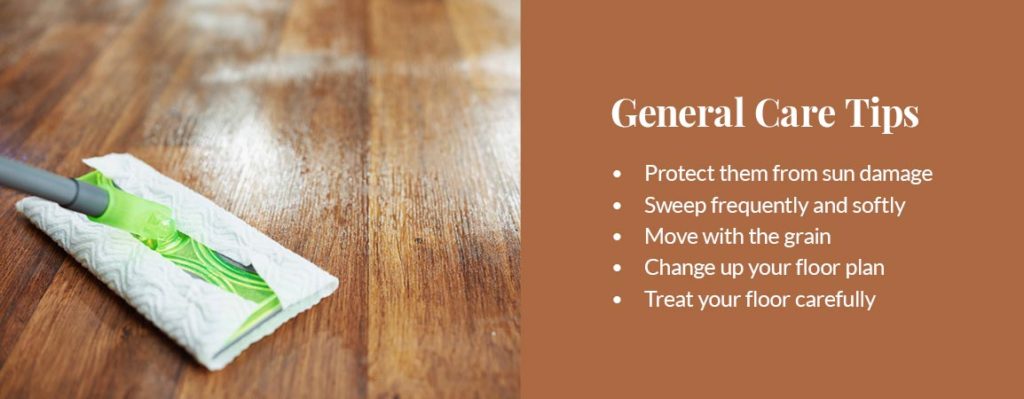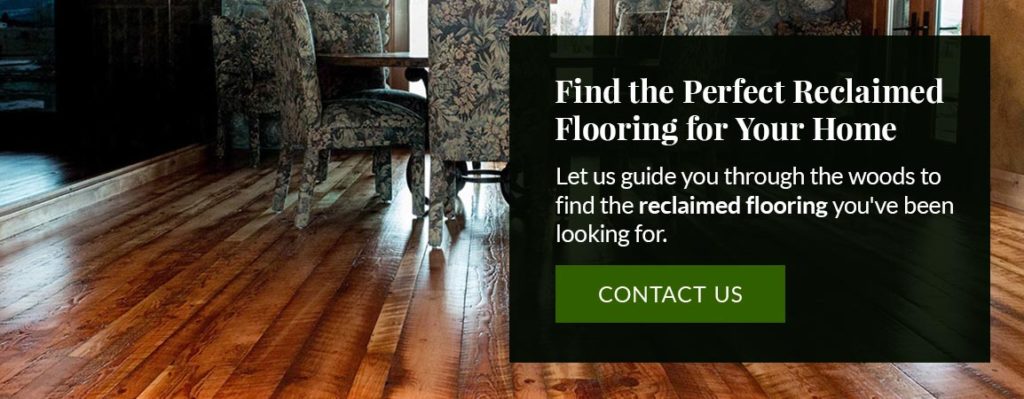Reclaimed hardwood floors give homes a touch of rustic grace and beauty. These environmentally friendly floors are available in a variety of styles and finishes, making it easy to find the best fit to complete your home’s interior.
In addition to being more stable than other flooring options, reclaimed hardwood floors increase your home’s value and appeal. They can also improve your indoor air quality by minimizing mold, dust and allergen collection.
To keep your floors looking their best and providing the most benefits, you need to give your wood floors attention and care. Wear and tear are inevitable — daily traffic and frequent use will always come with debris and the possibility of dents and dings. However, regular cleaning paired with preventive maintenance can keep your wood floors looking fresh. Recognizing the precautions you should take and developing a cleaning schedule will help keep your floor in the best condition possible.
Preventive Care
Regardless of the type of hardwood floors you have, you can take some preventive measures to keep your floors in good condition. Consider the following ways to protect your floors against damage from furniture, people and humidity:
- Furniture: Chair and table legs can leave scratches on your floors, whether you rearrange your room or accidentally bump into the coffee table. You can protect your hardwood from furniture by attaching soft plastic or fabric to the bottom of any hard surfaces. If you need to move your furniture, be sure to lift each piece rather than slide objects across the floor.
- People: You can place throw rugs in front of doorways and entries to help catch dirt and mud that people track inside. Setting a mat under the sink can help avoid water damage while washing dishes. Additionally, asking guests to remove their shoes will help keep your floor scuff-free — high heels, in particular, can cause a lot of scratches and dents.
- Humidity: Ensuring your home is not too humid in the summer or dry in the winter can also help keep your floors from warping or cracking.

How to Care for Reclaimed Wood Floors
Reclaimed wood is an elegant addition to your home that can last for generations. This character-filled surface needs care and maintenance to keep it in beautiful shape and reflect its beauty and age. When you give your reclaimed wood floor the attention it needs, you can enjoy its natural look for a lifetime.
Start with these general tips for cleaning reclaimed wood floors:
- Use protectors on the bottom of hard furniture.
- Limit your indoor humidity.
- Use wood cleaners and gentle soaps.
- Watch your sunlight exposure.
- Clean your floors thoroughly and often.
Basic cleaning tactics will help you keep your floor spick-and-span. A soft broom can help remove debris without leaving scratches behind, or you can vacuum your hardwood floors on the hard surface setting of your vacuum. Dust can be disastrous for your reclaimed wood, and regular sweeping and vacuuming are vital to keeping your rustic floor looking pristine.
Excessive moisture will also damage your reclaimed wood floors. Water can cause swelling and wear down the floor’s finish. Use a damp towel and a high-quality professional cleaner to clean up any spilled food or drinks gently. Gentle cleaners can remove debris and give your floors the shine they need to stay fresh and beautiful.
How often you’ll need to care for your floor depends on your finish and how much activity your floors see daily. Each floor finish is unique and knowing how to clean reclaimed wood floors can help them last.

Types of Finishes
There are a few types of popular hardwood finishes, each with its own pros and cons. Each finish requires different maintenance and care to keep it looking its best so your floors can continue enhancing your home. Some hardwood finishes include:
- Water-based polyurethane: This finish is quick-drying and easy for homeowners to apply themselves. It only takes a few hours of waiting before applying another coat and you can walk on these floors soon after they’re adequately dry. Homeowners can also choose from a variety of sheens with this finish and feel confident that it will keep their floors from turning yellow over time.
- Oil-based polyurethane: Oil-based polyurethane adds a durable layer to wood floors. With this finish, you can go a long while before you need to refinish your floors. This finish also makes it very easy to clean your floor — a simple vacuum or soft bristle broom can do the trick. However, oil-based polyurethane finishes are slow-drying and less resistant to yellowing than water-based polyurethane finishes.
- Molecular Bonding Oil: A molecular bonding oil finish is a natural product with no volatile organic compounds (VOCs), making it better for your health than other finishes. Oils help enhance wood’s natural beauty, defining the grain without making the floor look glossy or shiny. Oil finishes are less durable than other types of finish, so you’ll need to refinish high-traffic floors more often.
Flooring With Polyurethane Finishes
Polyurethane’s durability makes it a popular natural hardwood finish. Water-based polyurethane finishes have a quick drying time and help maintain your floor’s natural color over time. Oil-based polyurethane finishes are very easy to maintain and typically last quite a while before needing a refinish.
About every two years may be frequent enough to keep your floor vibrant and protected from daily activity. How often you need to refinish a polyurethane finish will depend on exposure and usage, among other factors. When you dust and mop these floors regularly, you can extend the time between each refinish.
When mopping your floors, ensure the mop is damp instead of wet. While you can use plain water for a natural cleaning or solution, a wood cleaner will be more effective in the long run. Avoid using vinegar or any other highly acidic floor treatment, as the acid will break down the finish. After mopping, dry the floor with a towel or a dry mop to remove streaks. To ensure your new coat adheres properly, be sure not to use cleaning products that leave behind any residue.
When you’re ready for a refinish, you may need to start by sanding your polyurethane floors. If you started with unfinished floors and later treated them with polyurethane, you can buff and recoat every few years to remove surface scratches and revitalize the top coat. However, if you have prefinished flooring, you will have to sand your floor down to the raw wood to remove the many coats of material on top. Since you’ll remove more material the first time, you’ll be able to refinish prefinished floors fewer times than unfinished floors without risking them becoming too thin.
Finally, you should avoid spot-finishing floors with a polyurethane finish because blending these spots later can be very challenging. Even if only a few areas are showing wear, refinishing the entire floor will help ensure a visually appealing and seamless result.
Flooring With Oil Finishes
Oil finishes emphasize the natural graining in floors and add a degree of solidity by seeping into the wood. They also give a low-sheen finish that highlights the essence of the wood while providing a smooth, warm touch. However, debris that breaks the surface can tarnish the natural beauty of oil finishes. Dirt and dust can scratch oil-finished surfaces, eventually dulling them.
To keep your oil finishes intact, be sure to vacuum your floor regularly. You should also give your floor a deep clean about once a month by using an oil soap that can restore small amounts of oil to the floor. All-purpose cleaners can leave a residue that scratches and damages oil surfaces, so you should always use an oil finish-friendly cleaner. You must also dilute these cleaning products before applying them to the wood to ensure they aren’t too harsh. Once your cleaning is complete, wait at least half an hour before walking on the surface.
An oil refresher can help prevent damage in high-traffic areas or places where spills are common, like the kitchen or dining room. You should always ensure the floor is clean before applying a refresher. You can use these products as you need them — a few times a year is usually enough to keep your floor pristine. Additionally, you can spot-clean oil finishes with wood soap.
Some oil finishes containing poly-resins protect better against stains and moisture because the poly-resin hardens once it soaks into the wood. However, preventive maintenance is the best way to keep your oil finish floors looking their best, so always clean and mop up spills quickly to prevent staining.

General Care Tips
Reclaimed wood floors enhance your home with elegance and rustic beauty. To keep your character-filled flooring as wildly magnificent as Montana, you must use the right tools and give your floors the treatment they deserve. Here are some wood floor maintenance tips you should be aware of to keep your floors looking their best.
Some general tips to keep in mind include:
- Protect them from sun damage: Drapes and sheers can help filter the harsh UV rays that can cause fading from sunlight exposure.
- Sweep frequently and softly: Soft-bristle brooms and non-abrasive products will clean your floors without leaving scratch marks.
- Move with the grain: When spot cleaning or mopping, use light pressure and follow the grain of the wood.
- Change up your floor plan: Rearranging your furniture will give the high-traffic areas of your floor a break while giving your home a fresh look.
- Treat your floor carefully: Be sure to use treatments that are safe for your floor, and always read the label of any product before using it. Take care to protect your floors from accidental water damage as well — if you’ve recently washed your rugs, ensure they’re completely dry to keep water from seeping into the floor.
Some floors will require more intense care than others. The finish on your floor may need more preventive maintenance and you may have to take additional steps before and after cleaning.
Cleaning Treatments to Avoid
Although different floors will demand different levels of attention, there are a few things you should avoid doing to make your floors last. Some things you should avoid on your wood floors include:
- Waxing reclaimed wood: These products penetrate the floor and prevent a new finish from adhering to the surface. When you use wax on your reclaimed wood floors, you’ll have to sand it away before you can refinish them.
- Steam cleaning: Water and heat can cause serious damage to your floor, including surface warping, wearing down the finish and pushing dirt and debris into the wood.
- Using all-purpose cleaners: Any cleaning product not specifically designed for wood will leave behind residue that can cause damage to the surface of your floor. All-purpose cleaners can leave you with bleach stains, scratches, dullness and dilapidation.
Keeping a Maintenance Schedule
Developing a maintenance schedule will help you remember to give your floors the attention they need. Create a daily schedule to clean everyday debris and plan ahead with a monthly and yearly schedule to ensure you keep up with maintenance in the long run.
You should plan to sweep daily or every other day. Homes with large pets and children will need to sweep more frequently to collect stray hair, fur and debris. Weekly vacuuming can give a deeper clean, especially to areas you may not normally sweep. Lifting and moving furniture can help you reach tricky corners and keep hard-to-reach spots free of dirt.
Every once in a while, you will need to treat your floors beyond regular maintenance. Mop and treat your floors about once a month with whatever method is best for your finish. Additionally, you should deep clean your floor every 2 to 4 years. You may need to apply a maintenance coat at this time as well.
The final objective on your long-term to-do list is to hire a professional every 10 to 15 years to sand and refinish your reclaimed wood floors. Refinishing will remove minor dents and scratches that your floor gained over time and restore it to its former glory.

Find the Perfect Reclaimed Flooring for Your Home
Since Superior Hardwoods of Montana went into business in 1977, our primary focus has been providing unique building materials and the finest wide-plank flooring out there. We’ve created lasting partnerships to ensure top quality that aligns with our sense of dedication to detail and integrity.
Reclaimed wood connects us to our values, including quality materials, unmatched beauty, stability and expert artistry. With our large variety of beautifully crafted selections, you can find planks as big, wide and beautiful as Montana, ready to bring out the beauty of your home.
Let us guide you through the woods to find the reclaimed flooring you’ve been looking for. Contact us to find out more about our floors and what we can do for you. We can help you find the floor that will give your home a stunning new look you’ll love for a lifetime.